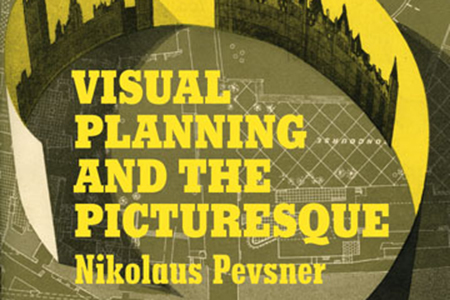
Visual Planning and the Picturesque
By Nikolaus Pevsner
Edited by Mathew Aitchison
With an Introduction by John Macarthur and Mathew Aitchison
Getty Research Institute, Los Angeles 2010
Pevsner’s Townscape
(from the introduction by John Macarthur and Mathew Aitchison)
This Volume presents a previously unpublished work by Sir Nikolaus Pevsner (1902 – 83), one of the most prolific and influential architectural historians of the twentieth century. Much of the book was published as journal articles in the «Architectural Review» (AR) in the 1940s and 1950s during Pevsner’s term as editor, but it is nevertheless surprising that he did not complete the book for publication under one cover, and that the manuscript has remained largely unknown. Seen as it was first intended, Visual Planning and the Picturesque provides a good example of how Pevsner related his roles of historian and critic, and its publication now answers some of the criticism that stymied his reputation late in his career and since his death. Had Visual Planning been published at the time of its writing, it would have shown more clearly that Pevsner’s interests often strayed from his core fields of art and architectural history to include a substantial body of work on town planning. Moreover, it would have seen him assume an influential position within the mid-twentieth-century British Townscape movement with which he is rarely associated.
Visual Planning is a book not of history per se, but of history put to use in a present-day argument about architecture and town planning, and it is intended to make the past available as precedent and inspiration for Pevsner’s contemporaries. The book is something of an anomaly among Pevsner’s vast oeuvre of history writing, in its straightforwardly instrumental character. This is interesting with regard to his detractors’ claims that Pevsner tended to surreptitiously mix his roles as historian and critic. Whatever distance there ought to be between these roles, they are clearly articulated in Visual Planning. Some readers will be surprised that the book’s argument, and indeed its raison d’être, is what is now known as Townscape. Attentive readers of the AR, of which Pevsner was an editor and prolific contributor, would know that he was involved in the journal’s campaign for a new concept of urban design. Throughout the 1940s, Pevsner wrote a number of historical essays on the picturesque and exegeses of theories that provided a pedigree for Townscape. Visual Planning shows that Pevsner was not merely involved, but a central figure of the movement—albeit he was commissioned for the task by Hubert de Cronin Hastings (1902 – 86), the owner and editor of the «AR». In the early years of World War II, Hastings ruminated on a body of opinion about modern architecture and urban design that had run through the journal in the 1930s, and he aimed to form this into an actual program relevant to postwar reconstruction. Hastings hired Pevsner to assist him in editing the journal in 1942, and it is likely that Visual Planning was commissioned as the core text of the new movement that would be published as a book by the «AR»’s parent company, the Architectural Press. The book went unrealized for reasons which are speculated in this book.
After several name changes, including “Visual Planning,” “Exterior Furnishing,” “Sharawaggi,” or even “Picturesque Planning,” the movement was finally launched under the banner “Townscape” in 1949. Parts of “Visual Planning” were published as articles before and after this time, while Pevsner continued into the 1950s to develop the manuscript for publication as a book. Although work on the manuscript appears to have ceased in the early 1950s, he alluded to the project in following years and was still thinking about it in the 1970s. He left a plan for the book, complete drafts of Parts I and II, illustrations, and notes for Part III. The book that follows has been transcribed and edited by Mathew Aitchison, in which the incomplete Part III was created by excerpting Pevsner’s published works.
Pevsner intended Visual Planning to address several issues: to reveal Britain’s unacknowledged contribution to planning history, to prove the fundamental role of the picturesque in Britain’s cultural production and artistic dispositions, and to show the commonalities of these fundamentals with the modernist architecture of his own day. These intentions were to be linked to provide the historical and theoretical premises for a new approach to urban design. Apart from the intrinsic value of such ideas, Visual Planning is also of interest for its historical value. In its mode of history writing and its place at the origins of Townscape, Visual Planning offers opportunities to revise our understanding of Pevsner and the role of history in midcentury modernism.
[…]
8 dicembre 2010
